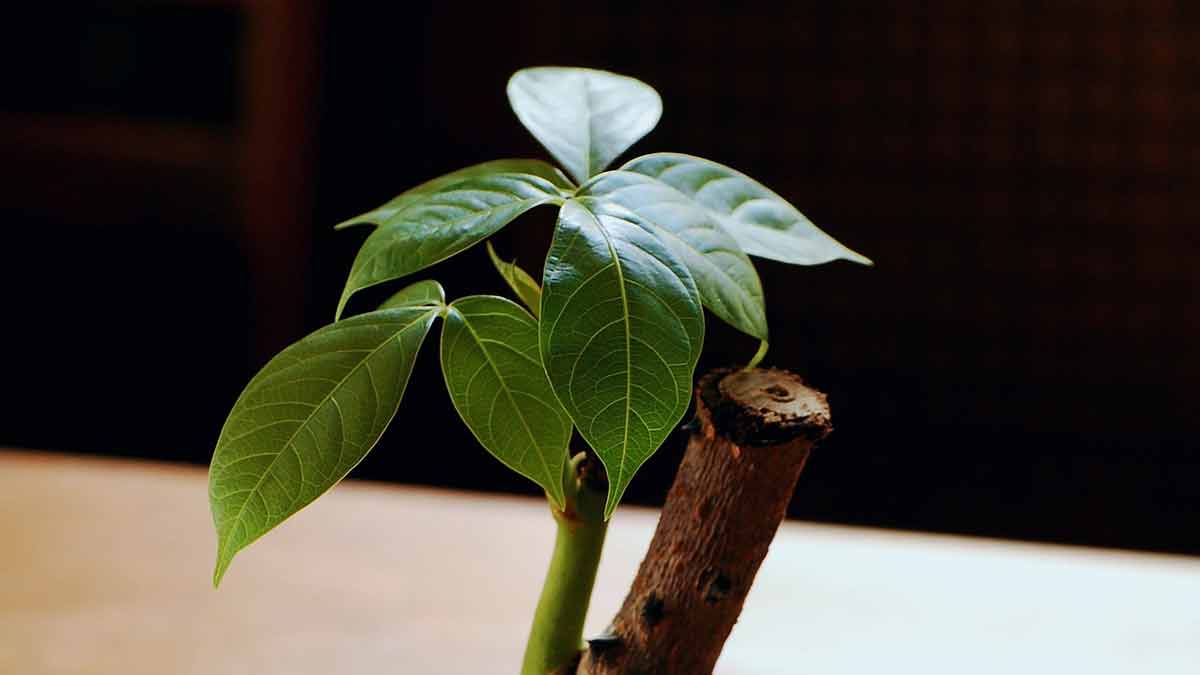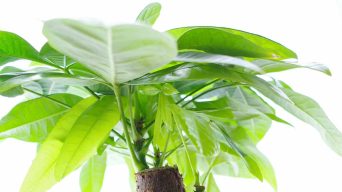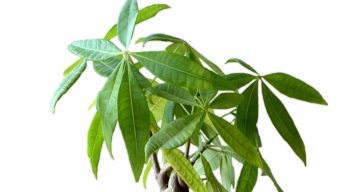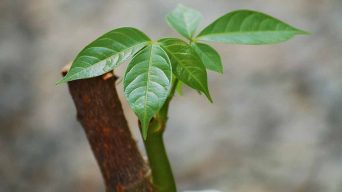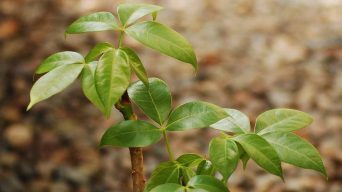Money Tree leaves curling can be caused by overwatering, low humidity, heat stress, or underwatering. To fix, adjust watering habits, maintain humidity levels, avoid extreme temperatures, and use appropriate soil mix. Pest infestations and wrong sun exposure may also cause curling.
Is your once-thriving money tree looking a bit down lately, with its leaves curling and losing their vibrant appearance?
Don’t worry; you’re not alone in this struggle.
Money tree leaves curling is a common issue faced by Pachira aquatica enthusiasts, but fear not—it’s fixable!
In this blog post, we’ll explore the various causes behind these distressed-looking leaves and provide practical solutions to bring your beloved indoor plant back to life.
Causes Of Curling Leaves On A Money Tree
Money tree leaves curling is a common problem that various factors can cause.
These may include inadequate watering, nutrient deficiencies, temperature fluctuations, low humidity, pest attacks, excessive sunlight exposure, and unsuitable soil.
Identifying the underlying cause of curling leaves is crucial in ensuring the health and well-being of your money tree.
Underwatering
Underwatering is a leading cause of curling leaves on Money Tree plants.
Insufficient moisture can trigger a survival mechanism in these resilient indoor favorites.
Pachira aquatica, commonly known as the Money Tree plant, relies on consistent watering to maintain its lush foliage and distinctive appearance.
Pay close attention to other signs around the plant and leaf curling to determine if your Money Tree might be suffering from underwatering.
For example, you may also observe wilting or drooping of new growths and the yellowing of older leaves.
Giving your Money Tree an adequate amount of water is crucial for preventing these symptoms.
However, avoid oversaturating the soil – overwatering can lead to root rot, further damaging your beloved green companion.
Lack Of Nutrients
One common cause of money tree curled leaves is a lack of essential nutrients.
Money trees require balanced levels of macronutrients like nitrogen, phosphorus, and potassium and micronutrients such as calcium and magnesium to ensure healthy growth.
Calcium plays a particularly significant role in the normal development of plant cells and tissues.
Neglecting proper fertilization can exacerbate this problem in your money tree plant.
To address nutrient deficiencies and prevent leaf curl, indoor plant enthusiasts must create an appropriate fertilization schedule based on the specific needs of the Pachira aquatica species.
Temperature Stress
Temperature stress is a common culprit behind money tree leaves curling, as these tropical plants thrive in stable environments.
Sudden fluctuations in temperature or exposure to drafts can cause the leaves to react defensively by curling inwards.
To mitigate this issue, carefully monitor your indoor plant’s surroundings and make necessary adjustments.
For instance, avoid placing your money tree too close to heating vents or air conditioners that may cause sudden changes in room temperature.
Similarly, keep it away from cold window panes during winter to prevent chilling effects on its roots and foliage.
Low Humidity
Low humidity is another common cause of curling leaves on Money Trees.
This can occur when indoor environments lack proper moisture levels, especially during colder winter or dry climates.
To fix this issue, you can increase the humidity level around your Money Tree by placing a humidifier near it or grouping it with other plants.
You can also mist its leaves regularly or place a tray filled with water near its base.
Also, avoid placing your plant near heaters or air vents that may further dry the surrounding air.
Pest Infestation
Pest infestation is one of the significant causes of money tree curling leaves.
Gnats, whiteflies, and aphids are common pests that can attack your plant.
These tiny insects feed on the sap from your plant’s leaves or stems, causing them to wither and curl.
To tackle pest infestations effectively, you can use insecticidal soap or neem oil to kill and deter their growth.
Inspect your money tree regularly for any signs of infestation so that you can address it before it spreads to other plants in your home.
Excess Sunlight
Excess sunlight is one of the leading causes of curling leaves in a money tree plant.
While this tropical plant can tolerate bright light, direct sunlight can be harmful and cause damage to its foliage.
The intense heat from direct sunlight can dehydrate the leaves, causing them to curl inwards as a protective mechanism against water loss.
To prevent excessive exposure to direct sunlight, ensure that your money tree is located in an area with bright indirect light instead.
If it’s impossible to avoid direct sunlight altogether, consider using sheer curtains or blinds to filter out some harsh rays while allowing adequate light for photosynthesis.
Unsuitable Soil Mix
Choosing the wrong soil mix for your money tree can lead to curling leaves.
The roots may fail to absorb sufficient water and nutrients to maintain healthy growth.
Choosing a well-draining soil mix that promotes proper airflow while retaining moisture is essential.
To ensure optimal conditions for your money tree, consider repotting it every two years into fresh soil with a suitable mixture of sand, peat moss, and perlite or vermiculite, depending on the availability in your area.
This will help promote healthy root development and prevent any further stress caused by an unsuitable soil mix.
Solutions To Fix Money Tree Curled Leaves
If you notice curled leaves on your money tree, don’t worry! There are simple solutions that can fix the issue.
Firstly, adjust the watering frequency and ensure the soil is moist but not waterlogged.
Secondly, provide proper nutrition through regular fertilization and avoid harsh chemicals.
Additionally, maintain an ideal temperature and humidity level using a humidifier or pebble tray.
If necessary, address pest infestations with natural remedies or insecticides, adjust light exposure, and repot in a suitable soil mix every two years.
Adjusting Watering Frequency
One common reason for curled leaves on a Money Tree is improper watering.
To fix this issue, you may need to adjust the frequency of your watering sessions.
On the other hand, underwatering can also be detrimental, and cause leaves to curl inwards or turn yellow.
To find the right balance, regularly check your soil’s moisture level by sticking your finger about an inch deep into the soil.
If it feels dry at that depth, it’s time to water your plant.
Remember that each Money Tree has different needs depending on its size and location, so take note of how long it takes for the soil to dry out between watering sessions not to overdo or underdo it.
Providing Proper Nutrition
Proper nutrition is essential to prevent and fix curled leaves in a Money Tree plant.
These plants need regular fertilization to thrive in their overall care routine.
It’s important not to go overboard with fertilization, though, as excess nutrients can harm your plant.
Signs that your plant needs more nutrition include yellowing leaves or brown tips on new growth.
Maintaining Ideal Temperature And Humidity Levels
Maintaining ideal temperature and humidity levels is crucial in fixing money tree curled leaves.
These plants thrive at temperatures between 65 and 80 degrees Fahrenheit, the optimal range for indoor environments.
If you live in a dry climate, consider misting your money tree regularly to increase its humidity levels naturally.
Maintaining suitable temperature and humidity conditions for your money tree plant will ensure its long-term health and reduce the likelihood of curled leaves caused by environmental factors.
Addressing Pest Infestations
Pest infestations can be a common cause of money tree leaves curling.
Spider mites, mealybugs, and scale insects are the most frequent invaders on money trees.
You may notice white spots or webbing on your plant if it’s infected with spider mites.
To address these pests, you must carefully inspect the entire plant for signs of infestation.
Once identified, isolate the plant from other houseplants until you have eradicated any pests present.
Spider mites can be eliminated by wiping down affected leaves with soapy water; however, more severe cases might require an insecticidal spray.
Scale insects and mealybugs can also be treated using rubbing alcohol or insecticidal soap applied directly onto them or on a soft cloth to clean off their sticky residue.
Adjusting Light Exposure
Money trees thrive in bright indirect light, and direct sunlight can scorch their leaves, leading to curling as self-protection.
As such, adjusting the amount of light exposure is crucial in fixing curled money tree leaves.
Move the plant away from windows that receive intense and direct sunlight, or use sheer curtains to diffuse it.
It’s important to note that these plants also require rest periods, so avoid keeping them under artificial grow lights 24/7; they need at least six hours of darkness daily.
In addition, some species may hibernate during winter months with reduced amounts of water and light requirements until spring, when growth resumes again.
Repotting With Suitable Soil Mix
Repotting your money tree with an appropriate soil mix can help prevent curled leaves and promote healthy growth.
The right soil mix provides the necessary nutrients and drainage for the plant to thrive.
Choosing a well-draining pot slightly larger than the current one is important when repotting.
Once you’ve chosen your new pot and soil mix, gently remove your money tree from its old container and loosen any tangled roots before placing it into the new pot.
Ensure the root ball’s top sits just below the rim of the new container.
Add enough soil around the edges to secure it in place but avoid packing it down too tightly as this could restrict water drainage.
Repotting with an appropriate soil mix helps prevent curled leaves and promotes overall plant health by ensuring adequate nutrition.
Preventive Measures To Avoid Money Tree Curling Leaves
If you own a money tree and want to avoid the hassle of dealing with curled leaves, it’s essential to take preventative measures.
These may include utilizing appropriate watering techniques, ensuring regular fertilization, monitoring humidity and temperature levels, and promptly identifying and addressing pest infestations.
By implementing these precautions, you can help maintain the health and appearance of your money tree.
Proper Watering Techniques
One of the most common causes of money tree leaves curling is improper watering techniques.
Overwatering or underwatering can cause damage to the roots, leading to curled leaves and even root rot.
When watering, use room temperature water and soak the soil thoroughly until it drains from the pot’s bottom.
Avoid letting your plant sit in standing water, leading to excess moisture and root rot.
Remember that every plant’s needs vary based on its environment and size, so paying attention to your money tree’s needs regarding proper watering techniques is essential.
Regular Fertilization
Regular fertilization is a critical preventive measure for keeping your Money Tree healthy and avoiding leaf curling caused by nutrient deficiencies.
The type of fertilizer you choose should be balanced with equal amounts of nitrogen, phosphorus, and potassium.
It is important to fertilize your Money Tree every two weeks during the growing season (spring and summer) with a half-strength solution mixed according to the instructions on the packaging.
During fall and winter, when growth slows down, reduce the frequency of fertilization to once per month at half strength.
Monitoring Temperature And Humidity Levels
Maintaining appropriate temperature and humidity levels is crucial in preventing money tree leaves from curling.
These plants thrive in warm, humid environments with consistent temperatures between 60°F to 75°F.
Inadequate humidity can cause leaf curl, yellowing leaves, and brown tips.
To maintain ideal conditions, consider using a humidifier or placing a tray of water near your plant to boost moisture levels in the air.
Regularly monitoring your plant’s environment will keep it healthy and thriving for years!
Identifying And Addressing Pest Infestations Early On
Pest infestations can cause severe damage to your money tree plant and lead to curling leaves.
Some common pests that affect money trees include spider mites, mealybugs, and scale insects.
One way to identify pest infestations is by looking for white or brown spots on the leaves or stems of your money tree.
You may also notice webbing or sticky residue on the plant.
If you suspect a pest problem, inspect the underside of the leaves as well since many pests like to hide there.
Treatments for different pests vary, but some options include insecticidal soap or neem oil.
Final Thoughts
Curling leaves on your money tree should be addressed, as they indicate underlying issues with the plant.
By understanding the common causes, you can take the necessary steps to fix and prevent further leaf curling.
Ensuring proper watering, nutrition, temperature, and humidity levels and addressing pest infestations can make all the difference in keeping your money tree healthy and vibrant.

